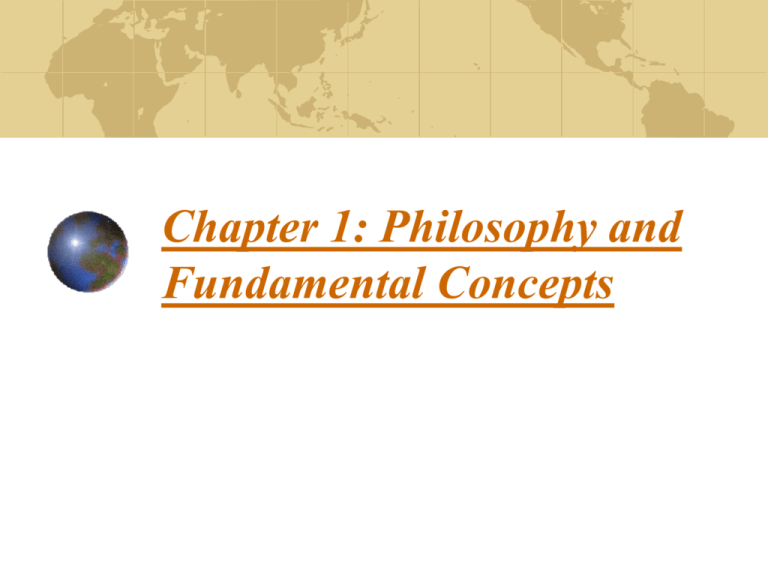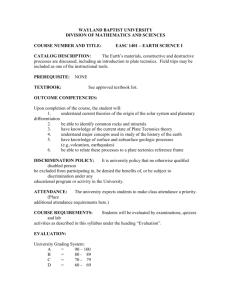Chapter 1: Philosophy and Fundamental Concepts
advertisement

Chapter 1: Philosophy and Fundamental Concepts geology science study of the earth physical - how the earth works historical - what the earth was like in the past environment total set of circumstances that surround an individual or community all physical conditions social and cultural conditions environmental geology applied geology interactions between humans and the earth environmental geology – areas of focus earth materials resources - in and out of place effects on human health natural hazards landscape and environmental analysis hydrologic processes resources pollution geologic processes analysis of global change geologic time fundamental concepts: population growth number one environmental problem exponential growth rate doubling time D=70/G figures p 10 tables p 11 & 12 carrying capacity fundamental concepts: sustainability environmental objective Environmental crisis deforestation w/soil erosion, water pollution, air pollution geologic resource mining development of ground and surface water resources what can the earth support for the long haul growth (?) economy Fund. concepts: systems & change system concepts open vs closed changes • input-output analysis - fig p 17 • average residence time - fig p 19 • rates feedback • positive - can cause runaway increase • negative - self-stopping response to disturbance • disturbance • complex response • thresholds earth system science Fund. concepts: systems & change uniformitarianism/actualism the present is the key to the past thePAST is the key to the future Fund. concepts: systems & change earth systems all closed (mostly) • exceptions: energy, meteoric additons all linked driven by energy four systems • • • • atmosphere hydrosphere biosphere lithosphere Fund. concepts: some earth processes are hazardous to humans assessment perception accommodation avoid plan for fundamental concepts: scientific knowledge & values science objective examination How does science work? • “method” – – – – – observation & data collection hypothesis testing & data collection revision/refinement publication/review • problems – historical aspect – multiple inputs and outputs – complex response Environmental Ethics morals - right vs. wrong values intrinsic/inherent instrumental moral status agents subjects neither Scientific values obligations to future generations effects of land use are cumulative importance of aesthetic considerations Ethical viewpoints Universalist fundamental principles: unchanging, eternal, universal modernists: develop universal laws through science Utilitarian the greatest good, for the greatest number of people environmentalists added: for the longest time Types of Environmentalism pragmatic resource conservation protect, develop, and use utilitarian conservation US Forest Service moral and aesthetic nature preservation nature for nature’s sake altruistic preservation US Park Service modern environmentalism concern for effects of pollution research, activism, focus on local issues US EPA global environmentalism concern for global changes climate, extinctions, population, pollution international treaties Environmental Justice environmental health as it relates to: race social standing wealth clean environment is a civil right examples environmental racism toxic colonialism Economics the study of the production, distribution, and consumption of capital capital - any form of wealth available for use in the production of more wealth uses assess relative values of goods and actions choose between competing options: cost-benefits analysis supply and demand supply: quantity of product available at a given price demand: amount consumers will buy at a given price the development cycle as supply decreases, cost increases and: use declines money for research & development increases more natural resources become economic efficiency of use increases substitution of/replacement with another resource Common property usually owned by all may encourage poor use open, unregulated access benefits of use are focused costs are widely distributed must be carefully managed privatization Political decision making policy made via a political process two models “power politics” “rational choice” Government actions Legislative laws funding Executive rules enforcement Judicial interpretation enforcement Laws NEPA 1969 Clean Air Act 1970, 77, 90 Clean Water Act 1972, 77, 96 Endangered Species Act 1973 TSCA 1976 RCRA 1976, 84 CERCLA 1980 SARA 1994 Chapter 3: Minerals & Rocks Atoms & Elements definitions atom: smallest part of a chemical element that can take part in a chemical reaction or combine with another element element: chemical substance composed of identical atoms that may not be separated into different substances by ordinary chemical means parts of an atom proton + charge atomic weight = 1 neutron 0 charge atomic weight = 1 electron - charge atomic weight = 0 Atoms & Elements terms atomic number = # of protons mass number = # of protons + # of neutrons • isotope - variations due to # of neutrons ionic charge = # protons - # of electrons Chemical bonding electron shells are most stable when full or empty types ionic bond – electrons exchanged Van der Waals bond - ionic attraction of sheets or chains covalent bond – shared electrons metallic bond - electrons are shared by all atoms most minerals have several types of bonds Minerals naturally occurring , solid, crystalline, known physical & chemical properties building blocks of rocks over 2000 identified - few common common mineral groups silicates (98% of crust by weight) quartz feldspar - most common mica ferromagnesian clay (weathering product of other silicates) oxides - hematite, bauxite, magnetite carbonates - calcite sulfides - pyrite, often in coal - acid runoff native elements - gold, silver, copper, diamonds Rocks aggregates of minerals rock texture - size, shape, arrangement of grains Igneous rock from solidification of molten rock intrusive vs. extrusive composition mafic intermediate felsic Igneous activity – molten rock formation temp up pressure down addition of water rises due to lower density differentiation crystal fractionation - enriched in remaining elements & volatiles Incorporation Igneous rock - intrusive magma texture cool slowly coarse grain:phaneritic, pegmatitic, porphyritic bodies batholith pluton laccoliths dikes and sills hydrothermal deposits rocks: granite, diorite, gabbro, peridotite Igneous rocks - extrusive lava volcanoes texture cool quickly fine: aphanitic, glassy, pyroclastic, porphyritic rocks rhyolite, andesite, basalt obsidian tuff, volc breccia, bentonite Igneous rocks – env. properties source of economic minerals economic rocks intrusive strong resistant to weathering resistant to fluid flow extrusive may be weak more susceptible to weathering less resistant to fluid flow Sedimentary rocks - formation weathering physical chemical erosion & transportation deposition - accumulation of sediments environment of deposition sedimentary basins transgression & regression sorting of sediments rounding of clasts burial & lithification Sedimentary rocks - types clastic - detrital gravel, sand, silt, clay non-clastic - chemical & biological limestone/dolostone - biological or chemical chert - biological (or post dep chem) evaporites - chemical(gypsum, rock salt) coal - biological Sedimentary rocks – env. properties source of economic minerals economic rocks strength varies with sediment type cementation bedding plane weaknesses fluid flow varies with sediment type cementation dissolution (esp. limestone) expansive clays Metamorphic rocks - formation Previously existing rock altered by heat • contact • hydrothermal pressure - fault zone heat & pressure • regional • impact foliated vs non-foliated: alignment of platy or linear minerals due to pressure Metamorphic rock types foliated: slate-phyllite-schist-gneiss non-foliated • • • • marble quartzite hornfels anthracite grade type of foliation size of mineral crystals index minerals Metamorphic rock – env. properties source of economic minerals economic rocks strength varies with foliation degree of metamorphism type of rock fluid flow is usually slow the rock cycle shows how rocks form and how they relate to each other each rock type can be transformed into one of the others Rock strength and deformation stress compression extension shear strain elastic - earthquakes plastic - folds brittle • joints • faults Strength of Earth materials response based on rock type time rock features/orientation • stratification • foliation • intrusions structures folds fractures joints faults Stratigraphy correlation unconformities rock laws cross cutting relationships original horizontality superposition mapping formations structures orientation of layers allows planning Earth’s Interior evidence seismology samples • volcanoes • drilling • meteors gravity magnetics Earth layers - core Fe & Ni 107 g/cm3 inner core - solid outer core - liquid convects source of magnetic field Earth layers - mantle ultramafic 45 g/cm3 lower mantle - plastic solid asthenosphere - partially molten upper mantle (lower lithosphere – rigid) Earth layers - crust rigid ocean 5 km thick mafic 28-30 g/cm3 continental 20-35 km thick intermediate to felsic 27-28 g/cm3 Plate Tectonics overall effects surface topography • continents • oceans geologic hazards - esp volcanoes and EQs resource locations climate Plate Tectonics Lithosperic plates rigid upper mantle & crust appx 100 km thick move • horizontal - 2-15cm/yr • vertical - isostacy Plate Tectonics: divergent boundaries plates pull apart ocean basins form topographic features rift valley (normal faulting) mid-ocean ridge geologic activity shallow EQ’s igneous activity - mafic & ultramafic history - age of the sea floor - fig p 51 Plate Tectonics: convergent boundaries (cont.-ocean or ocean-ocean) subduction - ocean lithosphere is overrun topographic features mountain ranges volcanic faulted ocean trench faults (reverse & thrust) Plate Tectonics: convergent boundaries (cont.-ocean or ocean-ocean) geologic effects shallow and deep EQ’s igneous activity - intermediate & felsic regional metamorphism (in long belts) ophiolites accreted terranes (west coast of North America) Japan, Andes Mtns., Cascade Mtns., New Zealand, Philippines, Aleutian Islands, Caribbean Islands Plate Tectonics: convergent boundaries (cont.-cont.) topographic features large mountains faults geologic effects shallow EQs Himalayas Plate Tectonics: transform boundaries topographic features complex faulting small mountains geologic effects shallow EQ’s California, Turkey Plate Tectonics: hot spots not a boundary topographic features volcanic chain (one or two active volcanoes at end of chain) geologic effects isolated igneous activity Hawaii, Yellowstone Plate tectonics and environmental geology resource zones oil gas minerals hazard zones earthquakes volcanoes landscapes climate





